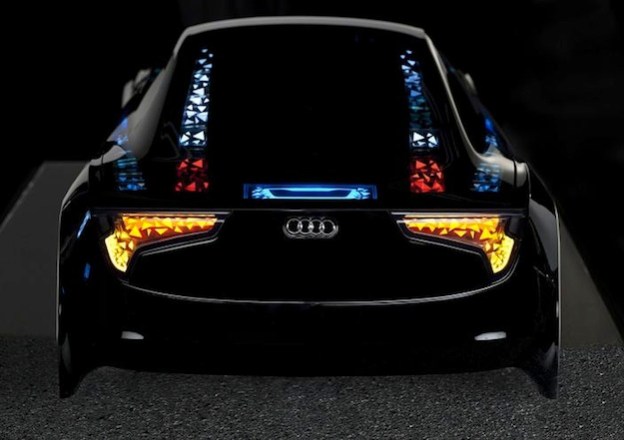
While most of the automotive technology we cover resides inside a car, there is a whole host of tech on the forward and aft of the cabin that most of us spend a considerable amount of time staring at, and very little time appreciating. We’re referring of course to lighting technology, and in this space, no company has applied technology more liberally than Audi.
The German company employees dozens of state-of-the-art lighting technologies, including some that haven’t made it past prototypes or onto roads in the United States yet. Here’s a closer look at how they work, why they’re integral to future automotive design, and when you can expect to see them lighting up that next dark country road.
Adaptive headlights
Adaptive headlights are becoming commonplace in today’s automotive marketplace. Audi’s adaptive headlights are a bit more complex than some of its competitors, which simply swivel with the turning of the steering wheel.
Audi adaptive headlights not only swivel up to 15 degrees but also adjust based upon various vehicle parameters. Audi’s vehicle lighting computer looks at road speed, steering angle, and yaw rate to adjust the aim of the headlights accordingly. These lighting changes can seem undetectable to the driver but can significantly increase road visibility.
Additionally, Audi’s adaptive headlights use a forward facing video camera to read not only oncoming headlights but also the taillights of vehicles on the road. The lighting computer will adjust the headlight range to optimize for the driver’s forward visibility while simultaneously limiting the effect on other drivers.
Distinguishing its adaptive headlight system from the rest of the industry further, the Audi MMI infotainment system will send satellite navigation information to the lighting computer as well. The lighting computer will again adjust lighting based upon the type of roadway, reacting differently when driving onto an onramp, on a curvy section of road, or even for left or right-hand driving, should a driver go from, say, France into England.
LED headlights
Audi’s LED headlights, which are separate from its LED daytime running lights, are available on models ranging from its high-performance R8 supercar down to one of its entry-level models, the A3.
LED headlights are beneficial for drivers for several reasons. Firstly, LED headlights are low maintenance and are designed to last the life of the vehicle. Secondly, they produce light with a color temperature of 5,500 Kelvin, which resembles daylight. This makes LED headlights much less tiring for the eyes. Additionally, LEDs consume five percent less energy than high-efficiency Xenon bulbs.

Currently Audi uses varying sizes and levels of intensity in its LED lighting technology. The daytime running LED system is comprised of 22 white LEDs and 22 yellow. On the A8 for example, only 10 lens modules are used for the low-beam headlights. The high-beam headlights, or “brights,” however, only require two four-chip LEDs that are intensified with a free-form reflection system.
Matrix Beam
Audi Matrix LED headlights, or “Matrix Beam” as Audi refers to it, are the future of headlight technology. Matrix Beam, though, is not currently legal in the US, but we’ll get to that in a minute.
Matrix Beam uses dozens of individual lighting segments, projected forward by lenses and reflectors. Depending on the situation, these segments can be dimmed or simply turned off. This, for instance, allows the light appear to be swiveling without requiring a mechanism to do so. The inside or outside segments simply dim, shifting the focus point to one side or the other.

Much like the adaptive headlights mentioned above, Matrix Beam takes into account satellite navigation location, as well as onboard video camera images to adjust lighting. The system is so precise, however, that Matrix Beam is capable of illuminating “the areas between several vehicles in complex situations,” according to an Audi press release, which is demonstrated in the photo in the above photo gallery with the man holding a flashlight and two beams of light on either side of him.
Matrix Beam is not yet legal in the US simply because the headlight regulations were, according to an Audi spokesman, “written long before software and sophisticated sensors were considered important elements of automotive lighting.” Audi is working alongside regulators to interpret these laws in order to allow Matrix Beam on future Audi cars bound for the States.
Laser taillights

An additional benefit of laser taillights is that in foggy conditions, the laser beam strikes the water droplets in the air, making them visible. The laser line is then seen as a large warning triangle.
OLED technology
OLED stands for “organic light emitting diode.” These lights are made from organic materials, unlike LEDs, which are made from semiconductor crystals. OLED material can be used on all parts of the vehicle for both safety lighting and non-essential visual detail. OLED is both versatile and extremely lightweight, making it ideal for future high-efficiency designs.

Audi recently showed a video (located below) of an OLED lighting concept called “The Swarm” where the entire back of the vehicle was coated in OLEDs and simulates taillights and turn signal indicators.
In addition to simple lighting, Audi imagines future OLEDs could be used on vehicle bodylines as well. Lighting up as the vehicle nears another car in the dark or illuminating features such as door handles.
Lastly, AMOLED (active matrix organic light emitting diode) have already been used by Audi as a stunning weight-saving technology in its R18 e-Tron Quattro electric racecar. Audi used an AMOLED screen to replace the review mirror as the R18 has no rear porthole.



